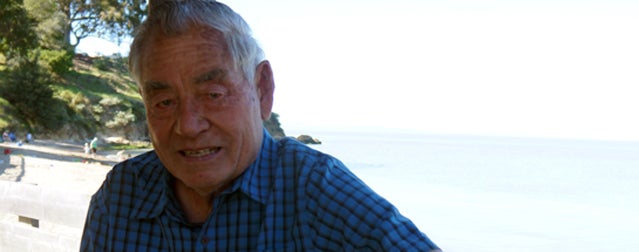
Frank Quan at China Camp Village Photo: Mary Catherine O'Connor
I found Frank Quan at a picnic bench, just off the beach, as the waters of San Pablo Bay lapped gently on the shore. It was an unseasonably warm, windless April afternoon and Quan was sitting in China Camp Village with the Ernie Stanton, the treasurer of , a group of volunteers that are scrambling to save China Camp State Park. The 1,500-acre park in southeast Marin County, near the town of San Rafael, is one of many California State Parks that have been slated for closure as of July 1, 2012, due to budgetary constraints.
Aside from a beloved park for mountain biking, road biking, trail running, hiking and boating, China Camp is Frank Quan’s lifelong home, and it was his family’s home for generations. China Camp was once a major shrimping village for Chinese immigrants who’d been forced out of San Francisco by white settlers who, essentially, no longer cared to compete with the very successful Chinese fishermen. When the state park was founded in 1977, Quan remained. He still lives in his family home, right there on the beach, and runs the small café and history museum in China Camp Village.
So the specter of China Camp's closure poses a conundrum that well exceeds the hand-wringing over other state parks that are facing the same fate. If this park isn't saved, where will 85-year-old Quan go?
When I asked him that very question, his jovial smile and attentive gaze softened. He looked off into the distance for a second, fell silent, and then regained his focus. “I’m very optimistic that we’ll be able to save the park,” he said, and later added, “I’m not going anywhere.”
The Friends of China Camp (FOCC) has submitted a proposal to the state to keep the park open by running it through a partnership, in which FOCC would manage many China Camp operations but the state would still own the land and hire staff. Along with the proposal, however, comes a rather daunting fundraising task. “We think we could run the park with an operating budget of $500,000,” says Bethanie Gilbert, a volunteer ranger at the park who is heavily involved in FOCC. “We think $250,000 would come through campground fees and parking fees.”
That leaves a good chunk of change for FOCC to raise elsewhere, but it’s getting very close to the quarter million dollars it needs for the first year of operation, thanks to an ongoing campaign and a very fruitful fundraiser held last week at a Chinese restaurant in San Rafael.
“We are by no means done,” says Gilbert, “but we’ve turned in our proposal to the state and they are in the process of evaluating it. They have until July 1 to make the call but they said they might have an answer for us within a month.”
The effort to save China Camp has brought the park’s many disparate user groups and stakeholders together, from the mountain bikers who come for the singletrack to the largely Latino families that utilize the picnicking areas to the Bay Area Chinese community, to whom China Camp Village is an important historical site.
Part of the budget crunch is due to the fact that most mountain bikers park along the road that runs through the park, rather than in the fee-based parking lots inside the park, thereby using the park without contributing to its upkeep.
That’s something that this reporter has been guilty of for years—though more as a force of habit than because I’m a cheapskate. It never occurred to me to drive into the park and pay, and I like to spin a bit on the road to warm my legs before hitting the trail. On a busy weekend, the road is packed with other cyclists doing the same thing, so the FOCC is looking at various changes to park management that would allow them to capture more parking fees.
“We’ve counted 140 cars parked on the road in one day,” says Quan. “Some of those guys are riding $7,000 bikes. You’d think they could pay a couple bucks to park.”
Ouch, Mr. Quan! My steed’s value has one less zero, but still, message received. I’ll be paying to play from now on, and hopefully beyond July 1.
As of today, 15 of the 70 California State Parks initially slated for closure have been saved by various third parties and sugar-daddies. Today, there are nearly 25 other parks that, like China Camp, may also remain open. But as the deadline nears, more group will likely propose plans to avoid closure as well.
The First 70 is a documentary about park closures, and we've covered the topic here. For a deeper dive into the history of China Camp, the death of the shrimp industry, and Quan's story, check out this great California Watch video:
–Mary Catherine O'Connor